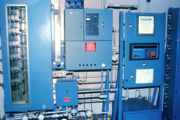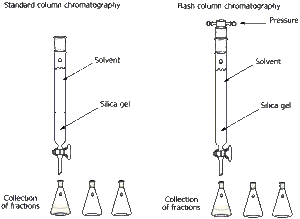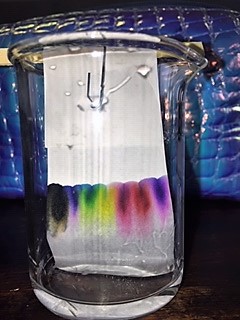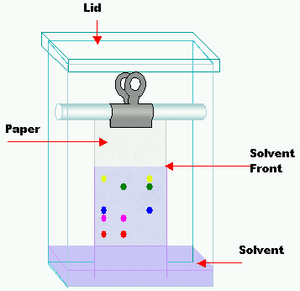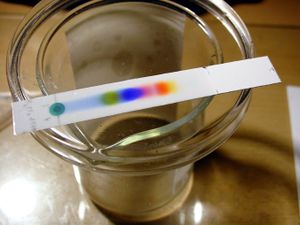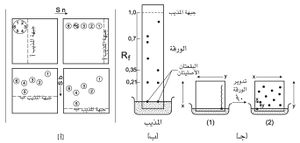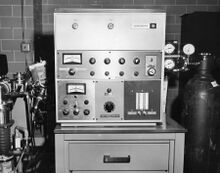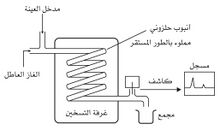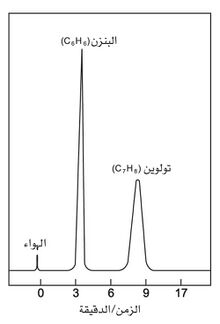كروماتوغرافيا
| جزء من سلسلة عن |
| الكيمياء |
|---|
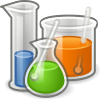 |
الكروماتوجرافيا أو الاستشراب، هي طريقة لفصل وتنقية المواد الكيميائية المختلطة. تعتمد الطريقة على أن مكونات المخلوط توزع نفسها بنسب مختلفة بين مكوني نظام ثنائي أحدهما متحرك والآخر ثابت. In chemical analysis, chromatography is a laboratory technique for the separation of a mixture into its components. The mixture is dissolved in a fluid solvent (gas or liquid) called the mobile phase, which carries it through a system (a column, a capillary tube, a plate, or a sheet) on which a material called the stationary phase is fixed. Because the different constituents of the mixture tend to have different affinities for the stationary phase and are retained for different lengths of time depending on their interactions with its surface sites, the constituents travel at different apparent velocities in the mobile fluid, causing them to separate. The separation is based on the differential partitioning between the mobile and the stationary phases. Subtle differences in a compound's partition coefficient result in differential retention on the stationary phase and thus affect the separation.[1] يمكن تصنيف طرق الكروماتوجرافيا المختلفة على أساس مكونات النظام الثنائي ، فمثلا كروماتوجرافيا الصلب-سائل تستخدم مكونا صلبا كالسيليكا أو الألومينا وأوراق الترشيح ومكونا سائلا متحركا كأي مذيب كالماء أو المذيبات العضوية. وكروماتوغرافيا الصلب-غاز تستخدم سائلا مدمصا على صلب كمكون ثابت وأحد الغازات كمكون متحرك. حيث ينادي العلماء حاليا بالرجوع إلى الطبيعة بعد موجة التلوث التي اجتاحت عالمنا نتيجة لاستخدام الكيمياويات المصنعة من مبيدات حشرية ومنظفات صناعية وغيرها وقد استجاب الأطباء حاليا لهذا النداء وبدأوا في استخدام الأعشاب والمنتجات الطبيعية كبديل للأدوية . فإذا سمعنا أن عشبا معينا يفيد في علاج بعض الأمراض ، فماذا يتبع العلماء للتحقق من ذلك ؟ إنهمم يحللون هذا العشب ليفصلوا كل مكون من مكوناته بحالة نقية، ويستخلصوا المادة الفعالة كدواء . معنى ذلك أنه لتعرف مخلوط معين لا بد من تحليله إلى مكوناته الأصلية بحالة نقية.
وطرق الفصل التقليدية مثل الترشيح والتقطير والترسيب غالبا ما نستخدم فيها التسخين والأحماض والقلويات، وهذه الطريقة تستغرق كثيرا من الوقت وكثيرا من الكواشف كما أن جزءا كبيرا من المادة يفقد في أثناء هذه العملية بجانب أن المركبات البيولوجية مثل بروتينات الدم مثلا.
Chromatography may be preparative or analytical. The purpose of preparative chromatography is to separate the components of a mixture for later use, and is thus a form of purification.[2][3] This process is associated with higher costs due to its mode of production.[4][5] Analytical chromatography is done normally with smaller amounts of material and is for establishing the presence or measuring the relative proportions of analytes in a mixture. The two types are not mutually exclusive.[6]
. . . . . . . . . . . . . . . . . . . . . . . . . . . . . . . . . . . . . . . . . . . . . . . . . . . . . . . . . . . . . . . . . . . . . . . . . . . . . . . . . . . . . . . . . . . . . . . . . . . . . . . . . . . . . . . . . . . . . . . . . . . . . . . . . . . . . . . . . . . . . . . . . . . . . . . . . . . . . . . . . . . . . . . .
أصل الاسم
Chromatography, pronounced /ˌkrəʊməˈtɒɡrəfi/, is derived from Greek χρῶμα chroma, which means "color", and γράφειν graphein, which means "to write". The combination of these two terms was directly inherited from the invention of the technique first used to separate pigments.[7]
التاريخ
 مقالة مفصلة: تاريخ الكروماتوغرافيا
مقالة مفصلة: تاريخ الكروماتوغرافيا
نشأت فكرة التحليل الكروماتوجرافي في جامعة قازان على يد العالم الروسي إيطالي المولد ميخائل تسڤيت سنة 1901 عندما حاول فصل الصبغات النباتية الملونة ، ولهذا أعطاها اسم الكروماتوجرافي (كلمة chroma باللغة اللاتينية معناها لون) إلا أن هذه الطريقة تتبع الآن هذه الطريقة تتبع بنجاح في فصل جميع المواد غير الملونة من مخاليطها سواء الصلبة أو السائلة أو الغازية.[8][9] He developed the technique and coined the term chromatography in the first decade of the 20th century, primarily for the separation of plant pigments such as chlorophyll, carotenes, and xanthophylls. Since these components separate in bands of different colors (green, orange, and yellow, respectively) they directly inspired the name of the technique. New types of chromatography developed during the 1930s and 1940s made the technique useful for many separation processes.[10]
Chromatography technique developed substantially as a result of the work of Archer John Porter Martin and Richard Laurence Millington Synge during the 1940s and 1950s, for which they won the 1952 Nobel Prize in Chemistry.[11] They established the principles and basic techniques of partition chromatography, and their work encouraged the rapid development of several chromatographic methods: paper chromatography, gas chromatography, and what would become known as high-performance liquid chromatography. Since then, the technology has advanced rapidly. Researchers found that the main principles of Tsvet's chromatography could be applied in many different ways, resulting in the different varieties of chromatography described below. Advances are continually improving the technical performance of chromatography, allowing the separation of increasingly similar molecules.
مصطلحات الكروماتوجرافيا
- Analyte – the substance to be separated during chromatography. It is also normally what is needed from the mixture.
- Analytical chromatography – the use of chromatography to determine the existence and possibly also the concentration of analyte(s) in a sample.
- Bonded phase – a stationary phase that is covalently bonded to the support particles or to the inside wall of the column tubing.
- Chromatogram – the visual output of the chromatograph. In the case of an optimal separation, different peaks or patterns on the chromatogram correspond to different components of the separated mixture.
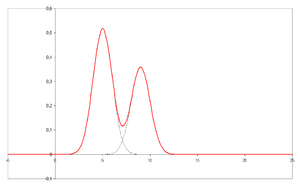
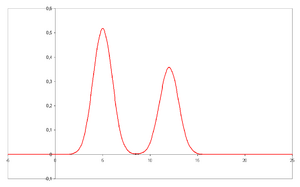 Plotted on the x-axis is the retention time and plotted on the y-axis a signal (for example obtained by a spectrophotometer, mass spectrometer or a variety of other detectors) corresponding to the response created by the analytes exiting the system. In the case of an optimal system the signal is proportional to the concentration of the specific analyte separated.
Plotted on the x-axis is the retention time and plotted on the y-axis a signal (for example obtained by a spectrophotometer, mass spectrometer or a variety of other detectors) corresponding to the response created by the analytes exiting the system. In the case of an optimal system the signal is proportional to the concentration of the specific analyte separated. - Chromatograph – an instrument that enables a sophisticated separation, e.g. gas chromatographic or liquid chromatographic separation.
- Chromatography – a physical method of separation that distributes components to separate between two phases, one stationary (stationary phase), the other (the mobile phase) moving in a definite direction.
- Eluent (sometimes spelled eluant) – the solvent or solvent fixure used in elution chromatography and is synonymous with mobile phase.[12]
- Eluate – the mixture of solute (see Eluite) and solvent (see Eluent) exiting the column.[12]
- Effluent – the stream flowing out of a chromatographic column. In practise, it is used synonymously with eluate, but the term more precisely refers to the stream independent of separation taking place.[12]
- Eluite – a more precise term for solute or analyte. It is a sample component leaving the chromatographic column.[12]
- Eluotropic series – a list of solvents ranked according to their eluting power.
- Immobilized phase – a stationary phase that is immobilized on the support particles, or on the inner wall of the column tubing.
- Mobile phase – the phase that moves in a definite direction. It may be a liquid (LC and capillary electrochromatography (CEC)), a gas (GC), or a supercritical fluid (supercritical-fluid chromatography, SFC). The mobile phase consists of the sample being separated/analyzed and the solvent that moves the sample through the column. In the case of HPLC the mobile phase consists of a non-polar solvent(s) such as hexane in normal phase or a polar solvent such as methanol in reverse phase chromatography and the sample being separated. The mobile phase moves through the chromatography column (the stationary phase) where the sample interacts with the stationary phase and is separated.
- Preparative chromatography – the use of chromatography to purify sufficient quantities of a substance for further use, rather than analysis.
- Retention time – the characteristic time it takes for a particular analyte to pass through the system (from the column inlet to the detector) under set conditions. See also: Kovats' retention index
- Sample – the matter analyzed in chromatography. It may consist of a single component or it may be a mixture of components. When the sample is treated in the course of an analysis, the phase or the phases containing the analytes of interest is/are referred to as the sample whereas everything out of interest separated from the sample before or in the course of the analysis is referred to as waste.
- Solute – the sample components in partition chromatography.
- Solvent – any substance capable of solubilizing another substance, and especially the liquid mobile phase in liquid chromatography.
- Stationary phase – the substance fixed in place for the chromatography procedure. Examples include the silica layer in thin-layer chromatography
- Detector – the instrument used for qualitative and quantitative detection of analytes after separation.
Chromatography is based on the concept of partition coefficient. Any solute partitions between two immiscible solvents. When we make one solvent immobile (by adsorption on a solid support matrix) and another mobile it results in most common applications of chromatography. If the matrix support, or stationary phase, is polar (e.g. paper, silica etc.) it is forward phase chromatography, and if it is non-polar (C-18) it is reverse phase.
نظرية الكروماتوجرافيا
الاحتفاظ
نظرية الأطباق
K is assumed to be independent of concentration, and can change if experimental conditions are changed, for example temperature is increased or decreased. As K increases, it takes longer for solutes to separate. For a column of fixed length and flow, the retention time and retention volume can be measured and used to calculate K.
تقنيات كروماتوجرافية على شكل صحون
كروماتوجرافيا عمودية
Column chromatography is a separation technique in which the stationary bed is within a tube. The particles of the solid stationary phase or the support coated with a liquid stationary phase may fill the whole inside volume of the tube (packed column) or be concentrated on or along the inside tube wall leaving an open, unrestricted path for the mobile phase in the middle part of the tube (open tubular column). Differences in rates of movement through the medium are calculated to different retention times of the sample.[13][14] In 1978, W. Clark Still introduced a modified version of column chromatography called flash column chromatography (flash).[15][16] The technique is very similar to the traditional column chromatography, except that the solvent is driven through the column by applying positive pressure. This allowed most separations to be performed in less than 20 minutes, with improved separations compared to the old method. Modern flash chromatography systems are sold as pre-packed plastic cartridges, and the solvent is pumped through the cartridge. Systems may also be linked with detectors and fraction collectors providing automation. The introduction of gradient pumps resulted in quicker separations and less solvent usage.
In expanded bed adsorption, a fluidized bed is used, rather than a solid phase made by a packed bed. This allows omission of initial clearing steps such as centrifugation and filtration, for culture broths or slurries of broken cells.
Phosphocellulose chromatography utilizes the binding affinity of many DNA-binding proteins for phosphocellulose. The stronger a protein's interaction with DNA, the higher the salt concentration needed to elute that protein.[17]
. . . . . . . . . . . . . . . . . . . . . . . . . . . . . . . . . . . . . . . . . . . . . . . . . . . . . . . . . . . . . . . . . . . . . . . . . . . . . . . . . . . . . . . . . . . . . . . . . . . . . . . . . . . . . . . . . . . . . . . . . . . . . . . . . . . . . . . . . . . . . . . . . . . . . . . . . . . . . . . . . . . . . . . .
كروماتوجرافيا مستوية
ويعد التحليل الكروماتوجرافي من أهم طرق الفصل الحديثة كطريقة سهلة وسريعة تحافظ على كيان المركبات المراد فصلها وتصلح لفصل مكونات أي مخلوط سواء كان في الحالة الصلبة أو السائلة أو الغازية وكان لهذا النوع من التحليل الفضل الأول في التقدم الملموس في كيمياء البروتينات والمضادات الحيوية والهرمونات والفيتامينات ... الخ. وقد نشأت فكرة التحليل الكروماتوجرافي في جامعة قازان على يد العالم الروسي ميخائيل تسڤيت سنة 1901 م عندما حاول فصل الصبغات النباتية الملونة ، ولهذا أعطاها اسم الكروماتوجرافي (كلمة chroma باللغة اللاتينية معناها لون) إلا أن هذه الطريقة تتبع الآن هذه الطريقة تتبع بنجاح في فصل جميع المواد غير الملونة من مخاليطها سواء الصلبة أو السائلة أو الغازية. ويمكن تقسيم الصل الكروماتوجرافي حسب نوع القوى المسؤولة عن الفصل التي تتوقف بدورها على الدعامة أو الصنف الثابت المستخدم إلى ثلاثة أنواع.
Paper chromatography
Paper chromatography is a technique that involves placing a small dot or line of sample solution onto a strip of chromatography paper. The paper is placed in a container with a shallow layer of solvent and sealed. As the solvent rises through the paper, it meets the sample mixture, which starts to travel up the paper with the solvent. This paper is made of cellulose, a polar substance, and the compounds within the mixture travel further if they are less polar. More polar substances bond with the cellulose paper more quickly, and therefore do not travel as far
Thin-layer chromatography (TLC)
Thin-layer chromatography (TLC) is a widely employed laboratory technique used to separate different biochemicals on the basis of their relative attractions to the stationary and mobile phases. It is similar to paper chromatography. However, instead of using a stationary phase of paper, it involves a stationary phase of a thin layer of adsorbent like silica gel, alumina, or cellulose on a flat, inert substrate. TLC is very versatile; multiple samples can be separated simultaneously on the same layer, making it very useful for screening applications such as testing drug levels and water purity.[18]
Possibility of cross-contamination is low since each separation is performed on a new layer. Compared to paper, it has the advantage of faster runs, better separations, better quantitative analysis, and the choice between different adsorbents. For even better resolution and faster separation that utilizes less solvent, high-performance TLC can be used. An older popular use had been to differentiate chromosomes by observing distance in gel (separation of was a separate step).
أنواع التحليل الكروماتوجرافي
يمكن تقسيم الصل الكروماتوجرافي حسب نوع القوى المسؤولة عن الفصل التي تتوقف بدورها على الدعامة أو الصنف الثابت المستخدم إلى ثلاثة أنواع:
كروماتوجرافيا الامتزاز
وفي هذا النوع تكون القوى المسؤولة عن فصل مكونات الخليط هي قوى الامتزاز, حيث تمتز مكونات الخليط المختلفة بدرجات متفاوتة باستخدام صنف ثابت له خاصية الامتزاز مثل كربونات الكالسيوم أو السيليكاجل . ففي كروماتوجرافيا الطبقة الرقيقة تنقط عينة من الخليط على مادة السيليكاجلالتي تغطي صفيحة زجاجية على شكل طبقة رقيقة , ثم يتصاعد المذيب من المستودع إلى أعلى هذه الطبقة وبعد مروره بموضع العينة فإن مكونات الخليط المختلفة تتحرك خلال طبقة السيلكاجل بمعدلات مختلفة بحيث المكونات الممتزة أكثر تتحرك أبطأ والنتيجة هي فصل النقطة الأصلية إلى مجموعة نقاط كل منها يحتوي على أحد المكونات
هو أقدم الطرائق، ويتلخص مبدؤه بما يلي: عند وضع محلول بتماس جسم صلب متمزز للمنحل solute يتثبت جزء من هذا الأخير على الجسم الصلب، وذلك نتيجة لحدوث توزع partition وقيام توازن يتوقف بصورة خاصة على شدة التمزز ومدى قابلية انحلال الجسم المنحل. ولتحقيق ذلك عملياً يصب مزيج الأجسام المراد فصلها منحلة في مذيب مناسب (الماء، الكحول) في قمة عمود شاقولي هو أنبوب مفتوح مُلئ بمسحوق جسم صلب اختياراً مناسباً (حجر كلسي، ألومين، طَلْق)، فيسيل المذيب الذي لم يتمززه الجسم الصلب إلى أسفل العمود، في حين يحتجز كل من الأجسام المنحلة على مستوى يزداد انخفاضه بنقصان شدة تمززه، وهكذا تتكون حلقات متوضعة بعضها فوق بعض . ويمكن زيادة المسافة الفاصلة بين الحلقات بإضافة سائل هو الشاطف الذي ينقل الحلقات نحو الأسفل بحله الأجسام المتمززة. فمجموعة هذه الحلقات، التي يظهر موقعها باللون أو بأي وسيلة أخرى، تكوِّن المخطط الاستشرابي chromatogram ويمكن إجراء الفصل إذا كان التظهير development كافياً وذلك بتقطيع العمود أو بإضافة شاطف يجرف الأجسام المتمززة نحو الأسفل في العمود وباستخلاصها الواحد بعد الآخر
كروماتوجرافيا التوزيع
تستعمل في طريقة الاستشراب هذه هلامة السيليس silica gel التي توضع بانتظام في عمود شاقولي، فيقوم السيليس، وهو الحامل البسيط، على تثبيت ماء الهلام، وهذا الماء يكوِّن الطور المذيب المستقر، وبعد إدخال المزيج المراد فصله في قمة العمود يصب شيئاً فشيئاً مذيب قوامه الكلوروفورم غالباً، فيهبط المذيب في العمود من دون نقل للماء، لكنه يَنقُل نحو الأسفل بسرعات مختلفة كلاً من مكونات المزيج، ويكون أسرع المكونات هبوطاً المكوّن الذي له أعلى معامل تفريق (معامل التفريق هو نسبة كتلة المكّون المنحل في حجم من المذيب المتحرك إلى كتلة المكون المنحل في الحجم نفسه من الماء)، وعندئذ يحدث الفصل وينجز بشطف كاف.
وهكذا يعد استشراب العمود column chromatography وسيلة دقيقة جداً لتحديد الهوية، وهو لا يحتاج إلا إلى ميليغرامات فقط من المادة المحللة.
أما الاستشراب على الورق paper chromatography فهو إضافة إلى بساطته، أكثر دقة ويجري بوضع عدة مكروغرامات من المزيج المراد فصله في زاوية من ورقة ترشيح موضوعة شاقولياً في جو شديد الرطوبة، وتقوم ظاهرة الشعرية capillarity بتسهيل نقل المذيب المتحرك في الورقة. وتتناسب سرعة انجراف الجسم عكساً مع انحلاله في الماء، ويتم تعرف كلٍ من البقع الحاصلة باستعمال كاشفٍ ملائم.
كروماتوجرافيا التبادل الأيوني
 مقالة مفصلة: امتزاز المرقد المتمدد
مقالة مفصلة: امتزاز المرقد المتمدد
يرتبط باستشراب التمزز استعمال مبادلات الشوارد (الأيونات) ion -exchangers، وهي مركبات شاردية ضخمة macro-ionic معدنية أحياناً كالألومينات السيليكونية silico-aluminates (الزيوليت Zeolite)، وعضوية في الغالب، أي راتنجات حاصلة بتفاعلات التبلمر polymerization أو التكاثف المتعدد polycondensation، ويكون بعضها هابطياً cationic مؤلفاً من نهايات كثيرة COO- أو SO-3 مرتبطة بشوارد H+، ويكون بعضها الآخر صاعدياً anionic مؤلفاً من زمرة N+R3 مرتبطة بشوارد OH- فإذا وضعت هذه الراتنجات بتماس محلول شاردي كانت قادرة على أن تبادل بشواردها H+ أو OH- شوارد من الإشارة نفسها (+ أو-) تأتي من المحلول. ويؤدي هذا التبادل، كما في التمزز، إلى توازن مع المحلول، لذلك يمكن فصل أنواع شاردية عدة وفق تقنية مماثلة لتقنية استشراب الامتزاز (الشكل 2). وهكذا تفصل الحموض الأمينية الناشئة عن تحلل البروتينات الطبيعية بالماء hydrolysis على راتنج مبادل للهوابط cations كما تُفصَل مشتقات الحموض النووية على راتنج مبادل للصواعد anions وتُنزع الشوارد من المياه الطبيعية باستعمال مبادلات الشوارد التي يمكن تنشيطها من جديد عندما تشبع
. . . . . . . . . . . . . . . . . . . . . . . . . . . . . . . . . . . . . . . . . . . . . . . . . . . . . . . . . . . . . . . . . . . . . . . . . . . . . . . . . . . . . . . . . . . . . . . . . . . . . . . . . . . . . . . . . . . . . . . . . . . . . . . . . . . . . . . . . . . . . . . . . . . . . . . . . . . . . . . . . . . . . . . .
كروماتوجرافيا غازية
 مقالة مفصلة: كروماتوجرافيا غازية
مقالة مفصلة: كروماتوجرافيا غازية
الكروماتوجرافيا الغازية هي طريقة حديثة عرفت تطوراً ونماء كبيرين، وفيها يبخر المزيج المراد فصله والمكون من سوائل طيارة، ويمدد بغاز حامل، ويرسل في عمود يحوي سائلاً مناسباً مثبتاً على حامل عاطل، فتنجرف مكونات المزيج الواحد بعد الآخر عند مخرج العمود. وتحدد هوية هذه المكونات وتعاير، بطريقة مناسبة كقياس تغير الناقلية الحرارية للغاز مثلاً. إنها طريقة سريعة وناجحة ودقيقة، وهي تستعمل في البحث وفي الصناعة كصناعة النفط مثلاً.
أبرز العلماء
ومن أشهر العاملين في مضمار الاستشراب ملڤن كالڤن Melvin Calvin كيميائي أمريكي (سانت پول، مينسوتا 1911) استعمل في التحليل الكيمياوي الاستشراب على الورق والتصوير الإشعاعي الذاتي autoradiography لمخططات الاستشراب، وحدد بدقة آلية التمثيل الضوئي باستعمال النظير الغاز كربون-14 (حامل جائزة نوبل في الكيمياء للعام 1961)، آرشر جون بورتر مارتن Archer John Porter Martin عالم كيمياء حيوية إنجليزي (لندن 1910) ابتكر عام 1944 بالاشتراك مع الكيمياوي الإنجليزي رتشارد لورنس ملنگتون سينج Richard Laurence Millington Synge (ليفربول 1914) الاستشراب على الورق لفصل الأحماض الأمينية الموجودة في البروتينات (تقاسم العالمان جائزة نوبل في الكيمياء لعام 1952).[19].
المصادر
- الكيمياء العامة تأليف كيفان ـ كلينفلند ترجمة د.سعد واصف، د. ماهر مصطفى الطبعة الثانية 1993 م معهد الإنماء العربي ، بيروت ـ لبنان
- الكيمياء العامة تأليف د.سالم لميباري وآخرين . الطبعة السادسة 1409 هجرية مكتبة الحرمين ـ الرياض
- الكيمياء العامة د.إبراهيم العوضي وآخرين . الهيئة العامة للتعليم التطبيقي ـ الكويت 1990 م
انظر أيضاً
| عمليات الفصل | ||||||

| ||||||
- Paper chromatography of amino acids on Wikibooks
- Aqueous Normal Phase Chromatography
- Multicolumn countercurrent solvent gradient purification (MCSGP)
- Chromatography in blood processing
المصادر
- ^ McMurry J (2011). Organic chemistry: with biological applications (2nd ed.). Belmont, CA: Brooks/Cole. pp. 395. ISBN 9780495391470.
- ^ González-González, Mirna; Mayolo-Deloisa, Karla; Rito-Palomares, Marco (2020-01-01), Matte, Allan, ed. (in en), Chapter 5 - Recent advances in antibody-based monolith chromatography for therapeutic applications, Elsevier, pp. 105–116, doi:, ISBN 978-0-08-103019-6
- ^ Alternative bioseparation operations: life beyond packed-bed chromatography T.M. Przybycien, N.S. Pujar and L.M. Steele Curr Opin Biotechnol, 15 (5) (2004), pp. 469-478
- ^ Ongkudon, Clarence M.; Kansil, Tamar; Wong, Charlotte (2014). "Challenges and strategies in the preparation of large-volume polymer-based monolithic chromatography adsorbents". Journal of Separation Science (in الإنجليزية). 37 (5): 455–464. doi:10.1002/jssc.201300995. ISSN 1615-9314. PMID 24376196.
- ^ González-González, Mirna; Mayolo-Deloisa, Karla; Rito-Palomares, Marco (2020-01-01), Matte, Allan, ed. (in en), Chapter 5 - Recent advances in antibody-based monolith chromatography for therapeutic applications, Elsevier, pp. 105–116, doi:, ISBN 978-0-08-103019-6
- ^ Hostettmann K, Marston A, Hostettmann M (1998). Preparative Chromatography Techniques Applications in Natural Product Isolation (Second ed.). Berlin, Heidelberg: Springer Berlin Heidelberg. p. 50. ISBN 9783662036310.
- ^ قالب:Cite OEtymD
- ^ Ettre LS, Zlatkis A, eds. (2011-08-26). 75 Years of Chromatography: A Historical Dialogue. Elsevier. ISBN 978-0-08-085817-3.
- ^ Ettre, Leslie S. (May 2003). "M.S. Tswett and the Invention of Chromatography" (PDF). LCGC North America. 21 (5): 458–467.
- ^ Ettre LS, Sakodynskii KI (March 1993). "M. S. Tswett and the discovery of chromatography II: Completion of the development of chromatography (1903–1910)". Chromatographia. 35 (5–6): 329–338. doi:10.1007/BF02277520. S2CID 97052560.
- ^ "The Nobel Prize in Chemistry 1952". nobelprize.org. Retrieved 25 August 2016.
- ^ أ ب ت ث Borman, Stu (1987). "Eluent, Effluent, Eluate, and Eluite". Analytical Chemistry. 59 (2): 99A. doi:10.1021/ac00129a735.
- ^ Ettre LS (1993). "Nomenclature for chromatography (IUPAC Recommendations 1993)". Pure and Applied Chemistry. 65 (4): 819–872. doi:10.1351/pac199365040819.
- ^ Manish T. "How does column chromatography work?". BrightMags. Archived from the original on 21 April 2017. Retrieved 7 April 2017.
- ^ Still WC, Kahn M, Mitra A (1978). "Rapid chromatographic technique for preparative separations with moderate resolution". J. Org. Chem. 43 (14): 2923–2925. CiteSeerX 10.1.1.476.6501. doi:10.1021/jo00408a041.
- ^ Harwood LM, Moody CJ (1989). Experimental organic chemistry: Principles and Practice (Illustrated ed.). WileyBlackwell. pp. 180–185. ISBN 978-0-632-02017-1.
- ^ Bourgeois S, Pfahl M (1976). "Repressors". In Anfinsen CB, Edsall JT, Richards FM (eds.). Advances in Protein Chemistry. Vol. 30. Academic Press. pp. 6–7. doi:10.1016/S0065-3233(08)60478-7. ISBN 978-0-12-034230-3. PMID 779429.
- ^ Bernard F (2003). Handbook of Thin-Layer Chromatography. Marcel Dekker Inc. ISBN 978-0824748661. OCLC 437068122.
- ^ "الاستشراب". الموسوعة العربية. 2007.
وصلات خارجية
| Chromatography
]].


